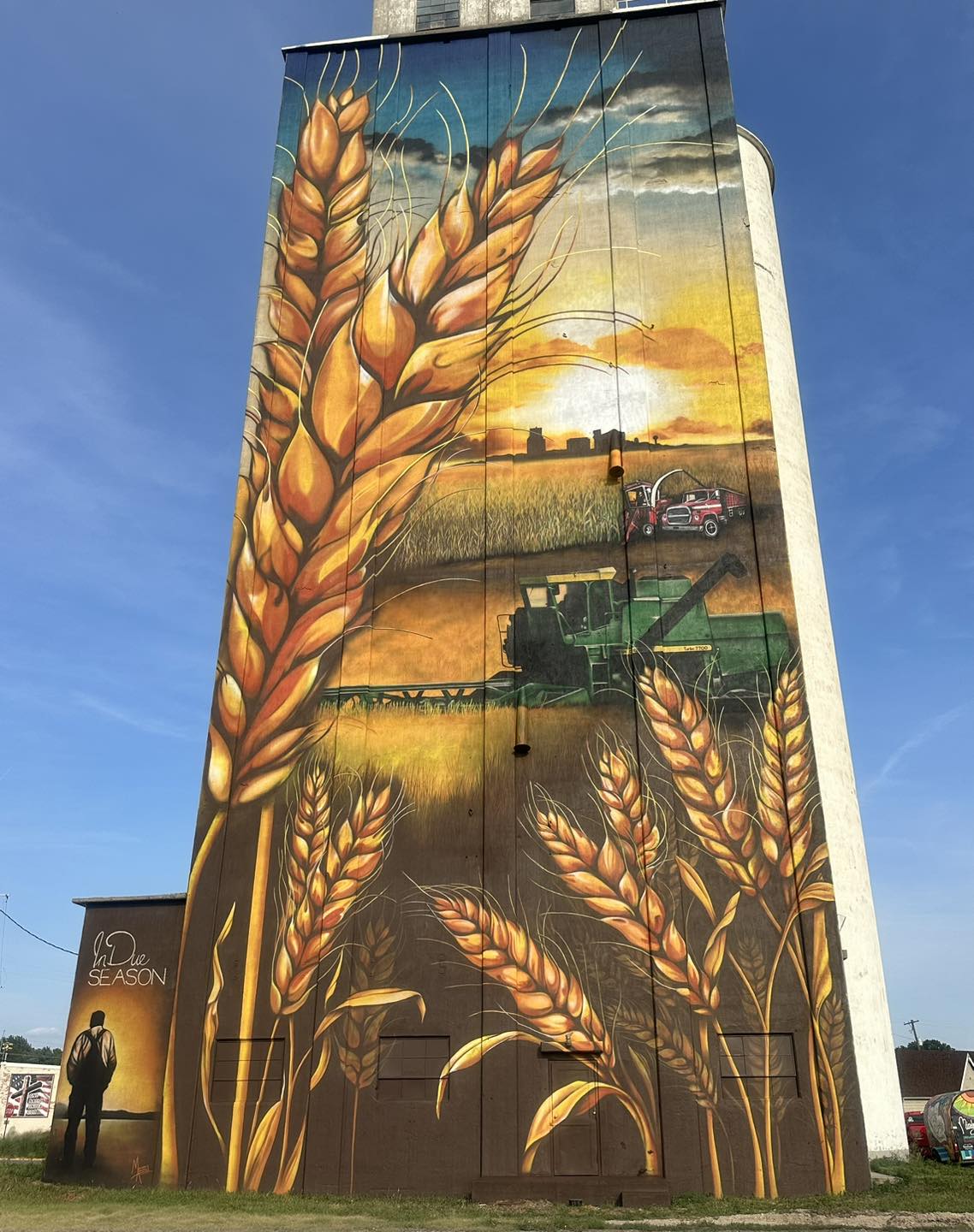Mindy Allen painted the elevator in Inman, Kan.
By Diego Flammini
Staff Writer
Farms.com
Mindy Allen (pictured above) is used to creating large works of art.
Her business, Mindy’s Murals, based out of Junction City, Kan., depends on it.
But then she received a call from a representative with the Inman Museum Association in Inman, Kan., to paint a mural on a 108-foot-tall grain elevator east of Highway 61.
“This was definitely the largest painting I’ve been asked to do,” Allen told Farms.com.
The mural is part of larger project to celebrate 150 years of Turkey Red winter wheat and the settlers who brought it to Kansas. And to raise money for a new museum facility to share the stories of custom cutters in the Inman and Buhler areas.
The piece of art features wheat plants, a John Deere combine, a red cutter and a farmer off to the side.
The combine being in John Deere green came after Allen set up a donation poll for the community to choose its color.
Once the paperwork became finalized, Allen got to work on creating the mural.
She starts with a digital drawing of the painting.
“On the digital drawings I can do all my measurements too,” she said. “And the elevator has columns on it that I used as natural markings.”
From there, Allen uses a doodle grid, a technique that allows artists to transfer and scale artwork onto a larger canvas.
She lays the doodle grid and the digital drawings on top of one another to get a precise look of how the mural will turn out.
“I could tell where the two large stalks of wheat were going to go,” Allen said. “I look at one specific drawing at a time to make sure it matches what I have on my iPad.”

From initial communication to completion, the mural took about six weeks.
Allen experienced multiple delays because of wind.
“We had to plan around the wind,” she said. “If it wasn’t windy, we’d start at the top. But I didn’t paint from top to bottom or vice versa. I did it more from background to foreground. I did the sky first because I knew there were going to be lots of things layered on top of that.”
Since finishing the mural, the picture has been shared widely on social media.
Allen is pleased with the attention her work is bringing to the community.
“I’m happy that people all around are sharing the mural,” she said. “If I did a painting that nobody saw, it wouldn’t be as fun for me. Being able to do something like this and have people want to come see it in person, or send me messages thanking me for my work, is super rewarding.”
Ron Regehr is the museum rep who initially contacted Allen to paint the mural.
Expanding the museum to share more local ag history, and having the mural to support those stories, is important for the community.
“More custom cutters came out of this area than any other place in the United States,” he told Farms.com. “We want to honor that. And innovation is huge here. One of the very first self-propelled silage cutters was invented about 5 miles down the road from Inman.”
That piece of equipment belonged to Pete Froese, who built it in 1946.
People in the community have stories of the Harvest Brigade, which existed during the Second World War.
“Massey Ferguson made propositions with sergeants that if it received steel and fuel for 500 combines, it would start in Texas and harvest all the way to Canada, and each person had to cut at least 2,000 acres per machine,” Regher said. “The sergeants worked on these combines and the government had planes flying overlooking for ripe wheat.
“All of these stories are out there, but there’s no home for them. That’s why the expansion is so important for us.”
For Regher, the mural represents community.
People can look at it and remember personal stories.
“The red cutter in the mural is the last one Jake Plett built,” he said. “And the farmer in the corner, everyone around here knows a farmer, dad or grandad, who stood out in the field waiting for the crop to be ripe. Everyone puts the story together in their own minds when they look at the mural.”